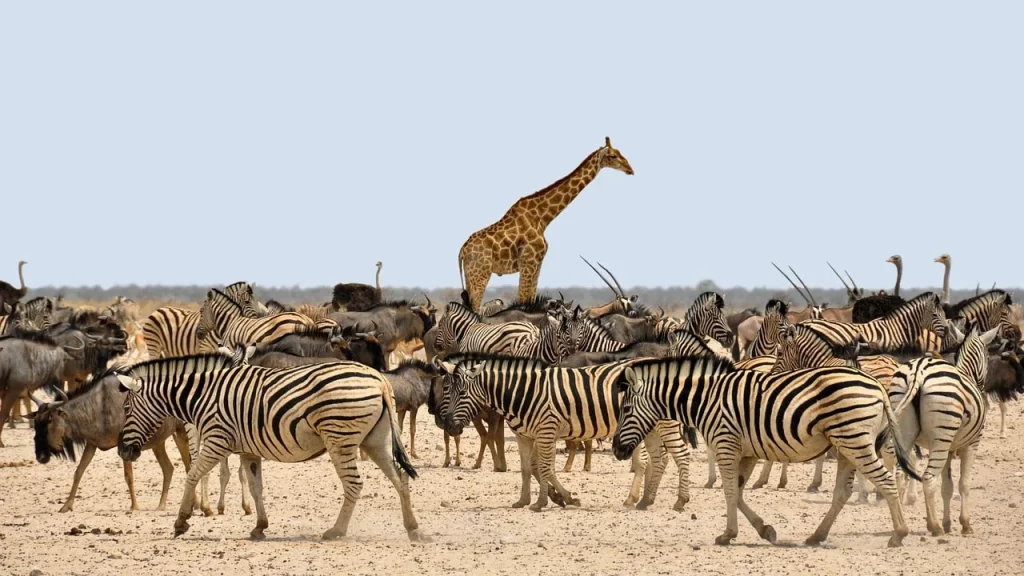Welcome to the fascinating world of giraffes, the tallest mammals on Earth! We’ll explore some astonishing facts about these gentle giants, whose long necks and distinctive spots have captivated humans for centuries.
From their unique anatomy to their intriguing behaviors, giraffes are full of surprises. Whether you’re a wildlife enthusiast or simply curious about nature’s wonders, you’re in for a treat. So, let’s embark on this journey together and uncover the secrets of these majestic creatures.
Giraffes are fairytale animals, almost heraldic – as if from the land of fables. They have extremely beautiful faces, huge eyes, very sensitive nostrils and oh, blue tongues!
Joanna Lumley
Giraffe Facts
Let’s start our educational journey into the world of giraffes. But remember to read everything carefully, because I created a quiz at the end of this article to test your knowledge. Prove to me that you are a giraffe master.
- Giraffes stand as the tallest land mammals, with just their legs surpassing the height of many people.
- Each giraffe has distinctive markings, similar to the uniqueness of human fingerprints.
- These majestic animals show a love for feasting on Acacia tree leaves, skillfully using their elongated tongues to avoid thorns.
- To their advantage, their elongated necks aid in reaching lofty leaves and spotting predators from afar.
- Giraffes are capable of sprinting up to 35 miles per hour across short distances.
- Their tongues, extending up to 21 inches, are adept at grabbing desirable leaves.
- Interestingly, giraffes have the same count of neck bones as humans, totaling seven.
- The offspring of giraffes are born while the mother stands, dropping approximately 6 feet to the ground.
- Remarkably, newborn giraffes can stand and stroll just an hour after birth.
- Their massive heart, weighing as much as 25 pounds, is essential for pumping blood to their elevated heads.
- Giraffes require water only sporadically, primarily deriving hydration from their plant diet.
- Socially, giraffes are non-territorial and often seen in transient herds.
- They exhibit a unique ambulatory pattern, moving both legs on one side forward simultaneously.

- Their ossicones, the horn-like structures on their heads, are enveloped in skin and hair.
- A giraffe’s spots can function as a thermal regulator, aiding in body temperature control.
- A group of giraffes is aptly termed a “tower.”
- Their coat design serves as effective camouflage amidst the savanna brush.
- Giraffes possess a specialized neck valve system to control blood circulation when lowering their heads to drink.
- They undergo a gestation duration of around 15 months.
- Young giraffes engage in frequent play, including mock neck battles.
- Their tongues are black or dark blue to prevent sunburn during feeding.
- They benefit from superb vision, aiding in predator detection.
- Giraffes are generally quiet, though they communicate through sounds like grunts and snorts.
- Typically, their lifespan in the wild spans up to 25 years.
- The primary predators of giraffes are lions, targeting young or weakened individuals.
- Male giraffes assess female reproductive status by tasting their urine.
- In the mating season, male giraffes partake in “necking” contests to woo females.
- Their hooves are as large as a dinner plate, measuring about 12 inches across.

- Giraffes exhibit unusual sleeping patterns, often slumbering upright and at brief intervals.
- Young giraffes are highly susceptible to predators, relying on their mother’s vigilance for survival.
- They possess a sophisticated gastrointestinal system, similar to cows with a four-chambered stomach.
- Their fur patterns play a role in social identification among their species, beyond just camouflage.
- With an acute sense of smell and hearing, giraffes remain keenly aware of their environment.
- Male giraffes often exceed females in height and weight, reaching over 18 feet in stature.
- Despite their imposing size, giraffes are noted for their gentle nature.
- Their long lashes serve as protection against sunlight and sand.
- Giraffes have been featured in cultural arts, mythologies, and literature across various civilizations and eras.

- Conservation initiatives for giraffes involve preserving their habitats and combating poaching.
- Not only are their necks lengthy, but they are also exceptionally strong, capable of delivering powerful blows.
- Giraffes are herbivorous ruminants, which means they chew cud as a part of their digestive process.
- They possess a distinctive skeletal structure in their neck, characterized by elongated cervical vertebrae.
- Underneath their spots, the skin pigmentation of giraffes is darker, offering additional sun protection.
- Occasionally, giraffes engage in osteophagy, consuming bones to augment their calcium intake.
- Juvenile giraffes experience rapid growth, sometimes up to an inch daily.
- Giraffes have evolved a specialized vascular system to manage cerebral blood flow when altering posture.
- Varying in hues from light tan to almost black, their coat shades differ based on subspecies and age.
- Thanks to their remarkable spatial perception, giraffes can deftly maneuver through dense woodlands.
- Giraffes, being social learners, often mimic the behaviors of other members of their group, aiding in their survival and adaptation.
- During periods of resource scarcity, giraffes have shown an ability to adapt their diet, consuming less preferred plants and even bark to sustain themselves.
Giraffe Myths

Having read all these interesting facts about giraffes, we now move on to the next section of our adventure. Here, we are going to uncover some popular myths and see what the actual truth is.
- Giraffes Are Silent Creatures
They are not mute. They communicate through a range of sounds like moans, snorts, and hisses, especially at night. Recent studies suggest they might even use low-frequency sounds beyond human hearing, helping them to communicate over long distances. - Giraffes Can’t Swim
While it’s rare to see a giraffe swim, they technically can. Their long legs and necks make swimming awkward, so they generally avoid water. But when necessary, they can manage short distances in water, showcasing their adaptability. - Giraffes Eat Only Leaves
They primarily eat leaves, particularly from acacia trees, but their diet is more varied. They also consume fruits, twigs, and occasionally flowers. This diverse diet provides them with necessary nutrients and helps maintain their health. - Giraffes Live Only in the Savanna
Although they are commonly associated with the African savanna, they inhabit various environments, including woodlands, forests, and savanna grasslands. Their adaptability allows them to thrive in different habitats across Africa. - All Giraffes Have the Same Pattern
Just like human fingerprints, each giraffe has a unique coat pattern. These patterns vary among the different subspecies of giraffes, and they can provide camouflage, aid in temperature regulation, and even play a role in social interactions among giraffes.
Giraffe Quotes

Giraffes, the skyscrapers of the animal kingdom, inspire awe and wonder. Their unique presence, towering yet graceful, has fascinated humans for centuries. In this section, I am going to share with you some of my favorite quotes about them.
The giraffe’s neck is a graceful tower, a natural wonder that challenges the sky.
Jane Goodall
Jane Goodall, a renowned primatologist and anthropologist, marvels at the giraffe’s distinctive long neck, seeing it as a symbol of nature’s elegance and grandeur.
I guess I always felt even if the world came to an end, a giraffe would still be standing.
Yoko Ono
Yoko Ono, an artist known for her thought-provoking work, shares her perception of giraffes as symbols of resilience and enduring grace amidst chaos.
Giraffes remind us that we all need a higher perspective on life.
Unknown
An anonymous quote that captures the essence of how giraffes, with their tall stature, inspire us to see beyond our immediate surroundings for a broader understanding of life.
Watching a giraffe eat leaves from a tree is like watching a living periscope rising above the forests.
David Attenborough
David Attenborough, famed for his nature documentaries, vividly describes the unique feeding behavior of giraffes, likening them to a periscope that offers a glimpse into the treetops.
A giraffe can seem a miracle of design, a strange assemblage of parts that somehow coheres into grace.
Diane Ackerman
Diane Ackerman, a poet and naturalist, reflects on the giraffe’s unique anatomy, viewing it as an extraordinary combination of features that come together in an elegant form.
Giraffe FAQ

We leave all these epic quotes behind and move on to the FAQ section. This is the last important part of our journey, as it’s the last piece of information before the quiz. Your time to shine is close.
- Will Giraffes Attack Humans?
They are generally peaceful creatures, and attacks on humans are extremely rare. They are more likely to run away when they feel threatened. However, like any wild animal, giraffes can become aggressive if they feel cornered or if their young are threatened. It’s always best to admire them from a safe distance. - Can Giraffes Lay Down?
Yes, they can lay down, although they don’t do it very often. When they do, they fold their legs underneath their bodies but keep their neck and head upright. Laying down can be risky in the wild because it takes giraffes a bit of time to get back up, which could make them vulnerable to predators. - Are Giraffes Endangered?
Sadly, giraffes are considered vulnerable to extinction. Their numbers have been decreasing due to habitat loss, poaching, and human-wildlife conflict. Conservation efforts are underway to protect giraffe populations and their habitats. - Can Giraffes Jump?
Giraffes aren’t known for jumping. Their large size and long legs make jumping impractical and potentially dangerous for them. They can run quite fast, though, reaching speeds up to 35 mph (56 km/h) over short distances. - How Do Giraffes Sleep?
They sleep standing up most of the time, which helps them quickly escape from predators if necessary. They doze off for short periods, adding up to just a few hours per day. Occasionally, they might sleep lying down with their neck curled back and their head resting on their body or the ground.
Giraffe Trivia

Welcome to the ultimate giraffe quiz! If you don’t answer any questions correctly, you might find yourself being enlisted in a giraffe’s basketball team for your height!
Conclusion
Our journey through the world of giraffes has been nothing short of extraordinary, akin to a safari of facts and surprises. These creatures, with their polka-dotted coats and sky-high aspirations, remind us of nature’s playful side.
Before you go, think about this: if a giraffe had a job, what do you think it would be, and why would it be the best at it? Let me know in the comments.
2 Sources Used For This Article

